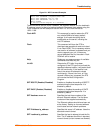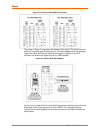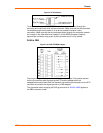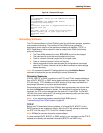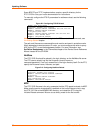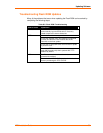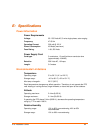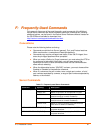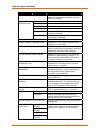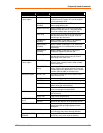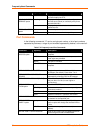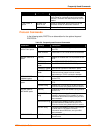
Updating Software
58
ETS Installation Guide
Some BOOTP and TFTP implementations require a specific directory for the
ETS*.SYS file. See your host’s documentation for instructions.
To manually configure the ETS IP parameters for software reload, use the following
commands.
Figure D-2. Configuring TCP/IP Reload
Local> SET PRIVILEGED
Password> SYSTEM (not echoed)
Local>> DEFINE SERVER IPADDRESS nnn.nnn.nnn.nnn
Local>> DEFINE SERVER SOFTWARE
“/tftpboot/ETS*.SYS”
Local>> DEFINE SERVER LOADHOST nnn.nnn.nnn.nnn
Local>> LIST SERVER BOOT
Local>> INITIALIZE RELOAD
Note: For instructions on how to log into the ETS to enter these commands, see
the Getting Started chapter.
The path and filename are case-sensitive and must be enclosed in quotation marks.
When attempting to boot across an IP router, you must configure the router to proxy-
ARP for the ETS, or use the bootgateway feature. For more information, see
Set/Define Bootgateway in the Commands chapter of the Device Server Reference
Manual located on the CD-ROM.
NetWare
The ETS*.SYS file should be placed in the login directory on the NetWare file server.
The ETS cannot actually log into the file server (since it knows no
username/password); it can only access files in the login directory itself. On the ETS,
specify the file server name, filename, and path.
Figure D-3. Configuring NetWare Reload
Local> SET PRIVILEGED
Password> SYSTEM (not echoed)
Local>> DEFINE SERVER NETWARE LOADHOST
fileserver
Local>> DEFINE SERVER SOFTWARE
SYS:\LOGIN\ETS*.SYS
Local>> INITIALIZE RELOAD
MOP
The ETS*.SYS filename is the only parameter that the ETS needs to reload via MOP.
Make sure the service characteristic is enabled on the host's Ethernet circuit, copy
the ETS*.SYS file to the MOM$LOAD directory, and reload the ETS using the
Initialize Reload command. Be sure to use binary mode for the file transfer.




